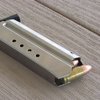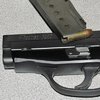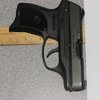berettaprofessor
Member
As I was shooting today, I suddenly found myself asking "why am I trying so hard to like the R51?" Are other R51 owners all asking the same question of themselves?
From other threads, forum members know that I kind of like the gun, but I have lots of reservations, from the steep learning curve of the disassembly/reassembly, to the cheap plastic trigger that wobbles from Kansas City to St. Louis, to the funky first round rack and the forward movement of the bullet on top of the magazine, and on to the $^@$& loose ejector that jumps up and jams the slide just as it passes the Pedersen block. Yet, despite the problems, I keep shooting the gun, because I really want it to be my go-to carry and home defense gun, primarily because I like the way it feels in my hand and points. I LIKE THE IDEA OF THE R51, NOT THE R51 THAT REMINGTON IS MANUFACTURING.
Right now, however there's no way that I'd trust it the R51 for carry...and I'm saying that after I've spent more time and money trying to "break it in" than I've ever done on a gun before. I've already got a much better carry gun that I trust. My choice would be my Springfield EMP with its 8 rounds, despite the fact that its 5 ozs heavier when loaded (30.4 ozs) and has a wider grip (1.20 inches) than the R51 (25.2 ozs heavy and 0.975 inches wide). I'm much more accurate with the EMP, despite the shorter barrel. There's no comparing the R51 trigger to the single action 1911 style trigger of the Springfield EMP, and the EMP is much less ammo-picky than the R51. There's also no comparing the takedown of the R51 and EMP; the EMP with its provided plastic "clip" for the rod is a cinch to clean, and even without the plastic clip it takes less sheer strength and cursing than that monstrous recoil spring of the R51. And forget about home defense. The R51 doesn't hold a candle to the 17 round mag, accuracy, and easy cleaning of the Beretta PX4 that lives in my nightstand.
Okay, granted, my EMP cost two and a half times as much as the R51 and is much better machined. Already, with more rounds on my EMP than the R51, the R51 has several large spots of wear while the EMP has only two small spots on the rail. But that's my point:
Remington Corporate, are you listening? The real market for the R51 is not the cheap $400 target of the Glock and Kel-Tec fanatics, it's the more discriminating and willing to spend market of the Kimber and Dan Wesson owners. Those who grabbed up the early R51, and those who are sticking it out to try the 2nd rendition, we are irrational about wanting the R51 to succeed. We love the look and feel of the pistol, we just want its potential to be realized. Please, double the price and do it right. I promise I'll buy the first remake I see on the market. Better trigger action, easier takedown and reassembly with maybe a tool or clip to replace the hand strength needed to fight the recoil spring. Better fitting, pinned ejector, a non-plastic trigger. Make it more than a expected 5000 life-round pistol. Make a pistol for the ages. We'll pay for it.
From other threads, forum members know that I kind of like the gun, but I have lots of reservations, from the steep learning curve of the disassembly/reassembly, to the cheap plastic trigger that wobbles from Kansas City to St. Louis, to the funky first round rack and the forward movement of the bullet on top of the magazine, and on to the $^@$& loose ejector that jumps up and jams the slide just as it passes the Pedersen block. Yet, despite the problems, I keep shooting the gun, because I really want it to be my go-to carry and home defense gun, primarily because I like the way it feels in my hand and points. I LIKE THE IDEA OF THE R51, NOT THE R51 THAT REMINGTON IS MANUFACTURING.
Right now, however there's no way that I'd trust it the R51 for carry...and I'm saying that after I've spent more time and money trying to "break it in" than I've ever done on a gun before. I've already got a much better carry gun that I trust. My choice would be my Springfield EMP with its 8 rounds, despite the fact that its 5 ozs heavier when loaded (30.4 ozs) and has a wider grip (1.20 inches) than the R51 (25.2 ozs heavy and 0.975 inches wide). I'm much more accurate with the EMP, despite the shorter barrel. There's no comparing the R51 trigger to the single action 1911 style trigger of the Springfield EMP, and the EMP is much less ammo-picky than the R51. There's also no comparing the takedown of the R51 and EMP; the EMP with its provided plastic "clip" for the rod is a cinch to clean, and even without the plastic clip it takes less sheer strength and cursing than that monstrous recoil spring of the R51. And forget about home defense. The R51 doesn't hold a candle to the 17 round mag, accuracy, and easy cleaning of the Beretta PX4 that lives in my nightstand.
Okay, granted, my EMP cost two and a half times as much as the R51 and is much better machined. Already, with more rounds on my EMP than the R51, the R51 has several large spots of wear while the EMP has only two small spots on the rail. But that's my point:
Remington Corporate, are you listening? The real market for the R51 is not the cheap $400 target of the Glock and Kel-Tec fanatics, it's the more discriminating and willing to spend market of the Kimber and Dan Wesson owners. Those who grabbed up the early R51, and those who are sticking it out to try the 2nd rendition, we are irrational about wanting the R51 to succeed. We love the look and feel of the pistol, we just want its potential to be realized. Please, double the price and do it right. I promise I'll buy the first remake I see on the market. Better trigger action, easier takedown and reassembly with maybe a tool or clip to replace the hand strength needed to fight the recoil spring. Better fitting, pinned ejector, a non-plastic trigger. Make it more than a expected 5000 life-round pistol. Make a pistol for the ages. We'll pay for it.




